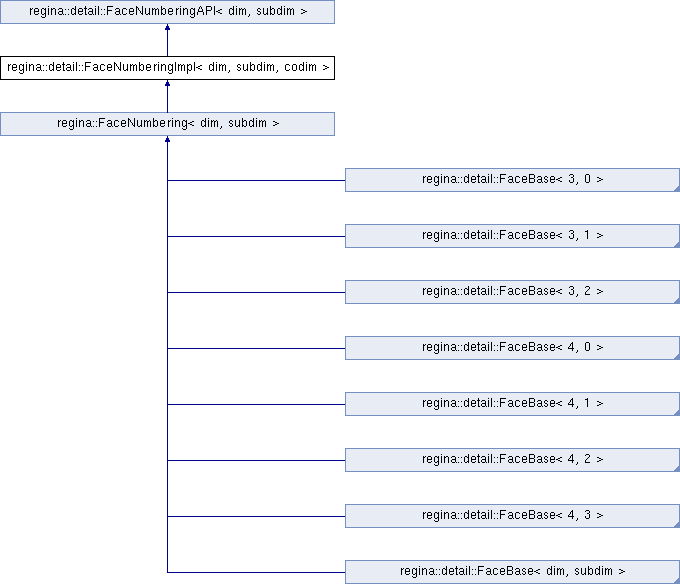Implementation details for numbering subdim-faces of a dim-dimensional simplex. More...
#include <triangulation/detail/facenumbering.h>

Static Public Member Functions | |
| static constexpr Perm< dim+1 > | ordering (int face) |
| Given a subdim-face number within a dim-dimensional simplex, returns the corresponding canonical ordering of the simplex vertices. | |
| static constexpr int | faceNumber (Perm< dim+1 > vertices) |
| Identifies which subdim-face in a dim-dimensional simplex is represented by the first (subdim + 1) elements of the given permutation. | |
| static constexpr bool | containsVertex (int face, int vertex) |
| Tests whether the given subdim-face of a dim-dimensional simplex contains the given vertex of the simplex. | |
Static Public Attributes | |
| static constexpr int | oppositeDim = (dim - 1 - subdim) |
| The dimension of the faces opposite these in a top-dimensional simplex of a dim-dimensional triangulation. | |
| static constexpr bool | lexNumbering = (subdim <= oppositeDim) |
true if faces are numbered in lexicographical order according to their vertices, or false if faces are numbered in reverse lexicographical order. | |
| static constexpr int | nFaces = binomSmall(dim + 1, lexDim + 1) |
| The total number of subdim-dimensional faces in each dim-dimensional simplex. | |
Static Protected Attributes | |
| static constexpr int | lexDim = (lexNumbering ? subdim : oppositeDim) |
| Whichever of subdim or oppositeDim uses lexicographical face numbering. | |
Detailed Description
class regina::detail::FaceNumberingImpl< dim, subdim, codim >
Implementation details for numbering subdim-faces of a dim-dimensional simplex.
This numbering scheme can be accessed via FaceNumbering<dim, subdim> or Face<dim, subdim>, both of which use this as a base class. End users should not need to refer to FaceNumberingImpl directly.
See the FaceNumbering template class notes for further information, including details of how the face numbering scheme works.
- Python
- This base class is not present, and neither is FaceNumbering<dim, subdim>. Python users can access these routines through the class Face<dim, subdim> (which in Python becomes Facedim_subdim, or one of the type aliases such as Vertex3, Edge2 and so on).
- Template Parameters
-
dim the dimension of the simplex whose faces are being numbered. This must be between 1 and 15 inclusive. subdim the dimension of the faces being numbered. This must be between 0 and dim-1 inclusive. codim the codimension (dim-subdim-1) of the faces being numbered. Ideally this would be specified directly as dim-subdim-1in the partial template specialisation, and this should be legal according to CWG1315; however, it fails to build under some versions of gcc (e.g., 10.2.0).
Member Function Documentation
◆ containsVertex()
|
staticconstexprinherited |
Tests whether the given subdim-face of a dim-dimensional simplex contains the given vertex of the simplex.
- Parameters
-
face a subdim-face number in a dim-simplex; this must be between 0 and (dim+1 choose subdim+1)-1 inclusive. vertex a vertex number in a dim-simplex; this must be between 0 and dim inclusive.
- Returns
trueif and only if the given subdim-face contains the given vertex.
◆ faceNumber()
|
staticconstexprinherited |
Identifies which subdim-face in a dim-dimensional simplex is represented by the first (subdim + 1) elements of the given permutation.
In other words, this routine identifies which subdim-face number within a dim-dimensional simplex spans vertices vertices[0, ..., subdim].
For the special case subdim == 1 (i.e., edges in a dim-dimensional simplex), you can also call this function in the form faceNumber(u, v), where u and v are two distinct vertex numbers in the range 0 ≤ u,v ≤ dim: this will return the number of the edge spanned by simplex vertices u and v. It does not matter whether u is smaller or larger than v.
- Parameters
-
vertices a permutation whose first (subdim + 1) elements represent some vertex numbers in a dim-simplex.
- Returns
- the corresponding subdim-face number in the dim-simplex. This will be between 0 and (dim+1 choose subdim+1)-1 inclusive.
◆ ordering()
|
staticconstexprinherited |
Given a subdim-face number within a dim-dimensional simplex, returns the corresponding canonical ordering of the simplex vertices.
If this canonical ordering is c, then c[0,...,subdim] will be the vertices of the given face in increasing numerical order. That is, c[0] < ... < c[subdim]. The remaining images c[(subdim + 1),...,dim] will be ordered arbitrarily.
Note that this is not the same permutation as returned by Simplex<dim>::faceMapping<subdim>():
- ordering() is a static function, which returns the same permutation for the same face number, regardless of which dim-simplex we are looking at. The images of 0,...,subdim will always appear in increasing order, and the images of (subdim + 1),...,dim will be arbitrary.
- faceMapping() examines the underlying face F of the triangulation and, across all appearances of F in different dim-simplices: (i) chooses the images of 0,...,subdim to map to the same respective vertices of F; and (ii) chooses the images of (subdim + 1),...,dim to maintain a "consistent orientation" constraint.
- Parameters
-
face identifies which subdim-face of a dim-dimensional simplex to query. This must be between 0 and (dim+1 choose subdim+1)-1 inclusive.
- Returns
- the corresponding canonical ordering of the simplex vertices.
Member Data Documentation
◆ lexDim
|
staticconstexprprotectedinherited |
Whichever of subdim or oppositeDim uses lexicographical face numbering.
◆ lexNumbering
|
staticconstexprinherited |
true if faces are numbered in lexicographical order according to their vertices, or false if faces are numbered in reverse lexicographical order.
◆ nFaces
|
staticconstexprinherited |
The total number of subdim-dimensional faces in each dim-dimensional simplex.
◆ oppositeDim
|
staticconstexprinherited |
The dimension of the faces opposite these in a top-dimensional simplex of a dim-dimensional triangulation.
The documentation for this class was generated from the following file:
- triangulation/detail/facenumbering.h
Copyright © 1999–2025, The Regina development team